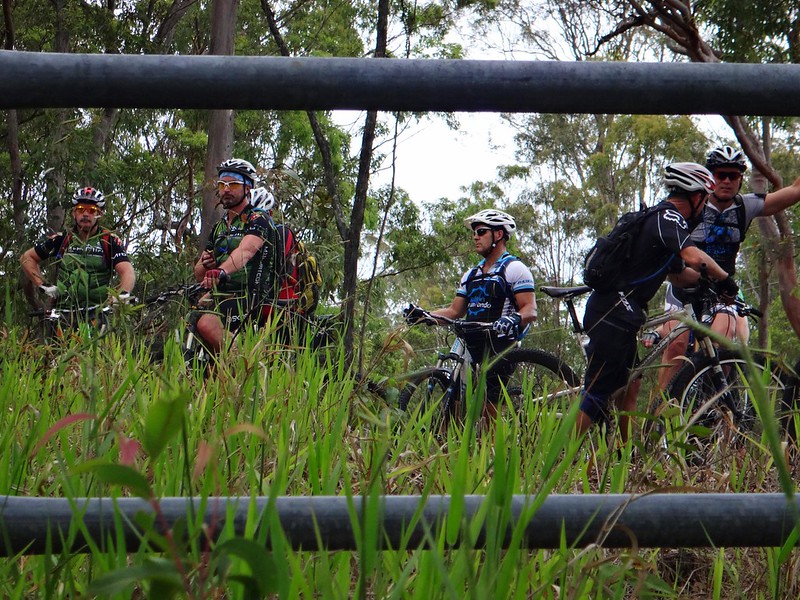Today’s adventure took us in a big loop from Mount Crosby and around Lake Manchester, stopping at a pleasant section of the Brisbane River along the way.
Continue Reading
Category: Brisbane
Local Trails
Bernie and Eric make amazing pizzas. They also live close to some fun mountain bike tracks. When Eric suggested we ride locally, then come back to his house for home-made pizza, beer and a swim, how could we refuse?
Mount Barney

“What lottery did I win to be able to see places like this every week?” I muttered to myself as rolled down a quiet road with the huge peaks of Mount Barney soaring above me.
Continue Reading
Man vs Mountain
We had the day off on Monday (it was a public holiday) so my friend Neil Bang decided to organize a group ride with some friends from MTBDirt.com.
Our route would take us from familiar single tracks at Bunyaville out to some steep and challinging fire trails at Clear Mountain.
It was going to be hard work.
Continue Reading
Daisy Hill

I felt like doing a big ride today, so my friend Dean agreed to accompany me on a long cross-town ride from my place to Daisy Hill. The plan was to try to stick to Bikeways as we rode the 75km across town, then do a few off-road tracks at Daisy Hill Conservation Park, then I’d finish the ride by heading west across town to visit my parents at Forest Lake.
It was also a chance to fill in some of the “missing links” on my global ride map.


Dean surprised me when he turned up on a fully laden Salsa Fargo touring bike, complete with panniers and bottle holders on the forks. It weighed a ton – which is saying something because a lot of my mates tell my I should send my bike to weight watchers.
As if on cue, as we started the ride, the rain started falling, so our first few kilometres along the bike paths were in cool humid dampness – which was actually more comfortable than riding in the blazing sun.

Before long we were winding through the swampy She-oak and Paperbark forests of the Boondall Wetlands. I love this part of the Moreton Bay Cycleway. Being so peaceful makes it hard to imagine that this track is so close to the busy Gateway Arterial Road.
And since I was in a lazy mood, I just stuck behind Dean all of the way, in his slipstream. He’s a strong rider and we were able to maintain some really fast speeds as we powered along the cycleway in our mini peloton of two mountain bikers.

A combination of high tides and recent rain meant that the track was slightly flooded in one or two places.

Eventually we reached the Gateway Bridge and made our way over the slow hump of the bridge and down the other side.

From there we rode through the Minnippi Parklands towards the Critereon track at Murrarie. Since I was still tailgating Dean and riding in his slipstream, he passed the Finish Line on the track just a split second before I did 🙂


We continued to head south, towards Daisy Hill along the Bulimba Creek bikeway.


When we eventually reached Daisy Hill, Dean led me up “Second Coming” track near the Buddhist Temple on Underwood Road. It was amazing to watch him push this heavy bike with no suspension along some winding steep single track. The bike rattled a bit on the bumps, by Dean handled it really well.

We rode down “Stringybark” trail and did a loop of the Quarry Lake in Neville Lawrie Reserve. By this time the sun was high in the sky, the day was starting to get hot, and I was sorely tempted to ditch my gear and jump in the water. I think Dean was relieved when I decided not to 🙂


Next time I’m there, I’ll definitely jump in. The water looked great on a hot day.

From there we headed up to the “Top Carpark” to top up on water, before riding down “Possum Box”.

And I got a lesson from Dean in how to ride a heavy no-suspension touring bike on some twisty single tracks.
Including the last leg of my ride to Forest Lake, I rode a total of 117km in just over 6 hours (excluding breaks). I burned 5,100 kcal and climbed a total of 1,150 metres. Riding this with Dean made it much easier – especially being able to slipstream him, and to benefit from his knowledge of where to go in a part of town that I don’t normally ride. I’ll rate this 8.5 out of 10 on the tough-o-meter. But if I did it solo, I’d probably rate it 9.5 out of 10.
Total climbing: 1279 m
Average temperature:
Total time: 08:51:20
More data
From the Mountains to the Sea

Brisbane is a wonderful city. I got to see a lot of it today in a nice big loop which covered the mountainous D’Aguilar National Park & Brisbabe Forest Park in the West, the CBD, and the Wetlands in the East. I took my time, which was enjoyable until the sun went down, and I realized I’d have to finish the last bit of my journey with lights.


I started by exploring a few trails at Bunyaville that I don’t ride too much – “Zigzag”, “Minivan” and “Darkside”. They’ve got wierd names. Someone tells me there’s the rusting wreck of a Mini Van somewhere in there, but I didn’t see it. All I saw was lots of winding flowing tracks.
After that I took a few back streets to Samford Forest where I stopped for a quick snack.


While I was relaxing, a couple of new faces showed up so I took their photos while they sped off down “Estate Break” – one of the steeper, more challenging fire trails in Samford Forest.

The “Three Ways” is a fun little intersection in the middle of Samford Forest with trails going off everywhere. The fun thing about it is this nice little dirt hill in the middle that you can ride over. You can’t do that at a bitumen three-ways 🙂

From there I rode over to Camp Mountain and did the tough short-climb to the summit. The climb is exhausting, which makes it easy to stop for a while at the top and enjoy the view.

It took me about an hour to ride from there down (and up) Centre Road to South Boundary Road. It was fun to look to the mountains of the Teviot Range, including Flinders Peak and recall that I’d ridden there only a few weeks ago. At that time I managed to get a photo of Brisbane as I looked north. This time I grabbed a shot of Flinders Peak as I looked south.

While I was admiring the view, a few more happy Mountain Bikers road by. It must be something about riding a mountain bike in the bush. It just makes you smile! It happened several times in the forest today – unlike in the city and on the bike paths. It must be something in the air 🙂

This time, when I got to the end of South Boundary Road, I followed “Goanna Trail” to the bottom, then climbed up Highwood Road. I have a love / hate relationship with this hill. I’ve climbed it several times, always after having ridden 50km through the national park, with tired legs. It’s a tough climb, especially with tired legs. But I’m always delighted when I make it to the top.


I then made the short ride from the top of Mount Coot-tha down “Powerful Owl” trail into the CBD and South Bank via the riverside Bicentennial Bikeway.

I think I prefer riding along the southern bank of the river. There always seems to be a lot going on, and I enjoy the view of the city across the river. When I’ve ridden on the northern bank, I think I was too close to the city to enjoy the view.


There was lots of activity by the river, including these rock climbers at the Kangaroo Point cliffs.

On the way out of Brisbane along Kingsford Smith drive I was lucky enough to get a great view of P&O “Pacific Dawn” leaving port for a week in the Pacific. She blew her horn while I was watching, which sounded loud – even from over a kilometre away. In the past I’ve always felt envious watching a ship leaving port, wishing I was on board. This time I felt much happier riding my bike. If they’d stopped the ship and asked if I’d have liked to hop on for a cruise, I would have graciously declined.
I’m content to ride my bike in the bush.
Today’s ride was 110km and took me almost 8 hours excluding breaks. I climbed almost 2,000 metres of vertical ascent and burned 6,000 kcal (about 11 Big Macs). This one rates 8 out of 10 on the tough-o-meter.
Total climbing: 2088 m
Average temperature: NAN
Total time: 09:30:28
More data
Paradise Lost
I had the pleasure today to read an old newspaper article from “The Brisbane Courier” which describes what the South Brisbane and West End areas of Brisbane were like in the 1820’s. The story was published in 1930 by someone who, fifty years earlier had made “the acquaintance of an old man – a time- expired convict – who was one of the first contingent of prisoners in 1825 to quit Redcliffe and ascend the Brisbane River in a cutter”. It’s a valuable recollection in that it describes the Paradise that was Brisbane prior to European Settlement.
If, like me, you’ve ever stood in your backyard and wondered what it would have been like three or four hundred years ago, or even earlier, then this article might give you a fleeting glimpse.
When I read this I get a better idea of the grief and anger many indigenous Australians feel about the loss of their land.
If you want, you can click on the image of the newspaper clipping to the left and read it. To make it easier, I’ve included a transcript of the article as well.
Source: The Brisbane Courier. 22 March 1930. Page 10.
THE BRISBANE RIVER.
100 YEARS AGO.
By AN OLD BRISBANEITE.
ITS SHALLOW WATERS.
RECENT issues of “The Brisbane Courier” have referred with a certain amount of pride to the fact that the P. and O. Coy. have decided to extend the service of their fine steamers to Brisbane. When one considers that less than a century ago men frequently waded across the Brisbane River at various spots between the present site of the Victoria Bridge and Queensport it can be realised that the work of improving the river has been one of great magnitude. Many years ago I was told by a gentleman then engaged in the pilot service at Brisbane that on one occasion at low tide he waded across the river from Queensport to Pinkenba. I had it from an ex-convict that during the years of the convict settlement in Brisbane, that is, after the year 1825, the soldiers when off duty were in the habit – at low tide – of wading about in the shallow pools of water where the Victoria Bridge now stands, and catching large quantities of fish. They caught the fish with their hands, and put them into bags or baskets slung over their backs.


SCENIC BEAUTIES.
It was my experience, more than half a century ago, to make the acquaintance of an old man – a time- expired convict – who was one of the first contingent of prisoners in 1825 to quit Redcliffe and ascend the Brisbane River in a cutter. This man was well educated, as was evidenced by the fragments of old manuscripts which he had written and placed at my disposal for perusal. He exacted from me a promise that I would not divulge the contents of his notes so far as they related to the convict system, but their perusal conveyed particulars of some dreadful incidents in the administration of the penal affairs of the settlement. The writer of those notes was an ardent lover of Nature, and the beauties of the scenery along the banks of the river probably appealed to him in a manner that was lost upon his fellow prisoners. He drew vivid pictures of the scenes of enchanting beauty which unfolded themselves as each successive reach of the river came into view. To use his own words: “It looked as though some race of men had been here before us, and planted this veritable garden of Eden.” The convicts were being conveyed to a prison from which possibly the majority would be released only by death, and yet the gateway to that prison lay between river banks lined with foliage whose beauty it were almost impossible to describe. Skirting the water’s edge for miles on each side of the river was dense vine-clad jungle, festooned with the blue and the purple convolvulus, while on the tidal brink grew the beautiful salt-water lily – its flower white as alabaster, its glorious perfume filling the air with fragrance. Kingfishers – some scarlet breasted, others white, all with backs of azure blue – darted hither and thither, while anon the solitude was disturbed by the raucous laughter of the kookaburra.


MAN VERSUS NATURE.
But the conditions of an earthly paradise were not to continue indefinitely, for in the course of time – particularly after the abolition of the convict system, and with the advent of free colonists in the Brisbane area – there came the inevitable day when
“The sound of the axe was heard in the land” –
when the war of devastation – man versus Nature – called by most people the march of progress – began, and the beautiful jungles were swept away. A few giant Moreton Bay fig trees were spared for some years longer. One of these stood in William-street, where now is the residence of Mr. Tom Mulcahy, of the Home Secretary’s Department. Another grew on the present site of the Treasury Buildings. Prior to the erection of these buildings that grand old tree stood sentinel over the Chief Secretary’s office – a small one-storied building, where some of the most important laws in force in Queensland first saw the hand of the Parliamentary draftsman. It was under the shadow of that old tree that Sir Thomas M’Ilwraith – then Premier – signed the historical telegram to Mr. H. M. Chester, police magistrate of Cooktown, instructing him to proceed post haste to New Guinea to hoist the Union Jack on the shores of Port Moresby, and to proclaim the annexation of New Guinea in the name of Great Britain. Incidentally it may be stated that M’Ilwraith’s action was repudiated by the Imperial Government, of which Gladstone was the head.



NATURE’S FAIRY BOWER.
One of the most enchanting spots within the Brisbane area was an immense jungle in the western portion of South Brisbane. It began at about the spot where the Victoria Bridge now stands, and it followed the course of the river right away to Hill End, along the whole length of what is now the Montague-road. This jungle was a tangled mass of trees, vines, flowering creepers, staghorns, elkhorns, towering scrub palms, giant ferns, and hundreds of other varieties of the fern family, beautiful and rare orchids, and the wild passion flower. While along the river bank were the waterlily in thousands, and the convolvulus of gorgeous hue. What posterity lost by the destruction of this magnificent jungle in all its pristine glory only those who were privileged to see it can form any conception. Here at our very door we had a wealth, a profusion, of botanical beauty which can never be replaced by the hand of man. Too late have we recognised the desirableness of conserving these glorious works of Nature. The Lamington plateau and Mount Tamborine certainly are beauty spots, and rich from a botanic point of view, but it is not every city dweller who can get to them. A few weeks ago there appeared In the “Courier” a letter from the pen of Mr. Fred. W. Taylor, dated North Tamborine, February l8, in which these words occur: “On ascending the mountain (Tamborine) from the Tamborine station one travels through avenues of wonderful scrub, with palm trees waving their proud plumes to the whispering breeze, and there are vast reserves of virgin scrub prolific in orchids, staghorns, &c., on stately forest trees.” These words would have applied with equal truth to the magnificent stretch of primeval foliage at West End had the early residents of Brisbane exercised sufficient foresight to preserve to posterity that magnificent botanical heritage.
GRIM RELICS.
It was during the destruction of this jungle that evidence of the brutal convict system was brought to light, for, amid this primeval grandeur, there were found the skeletons of several human beings, rusted leg-irons still encircling the bones. Obviously the convicts had escaped from the settlement – either by crossing the river on logs or by wading across at low tide. They preferred to die in this veritable garden of Nature rather than continue to live amid all the horrors of the convict system. But while all lovers of Nature must deplore the destruction of these enchanted spots, there is consolation in realising that after all such destruction was the first step in the direction of a free settlement, which displaced the brutal and degrading convict system.
We Love Brisbane
Liz and I took the kids into the city on Sunday for a ride on the City Cat, a stroll around South Bank, and a wander through GOMA. I’ve lived in this wonderful city most of my life, and I think I take it for granted, because I was quite surprised how beautiful it is.
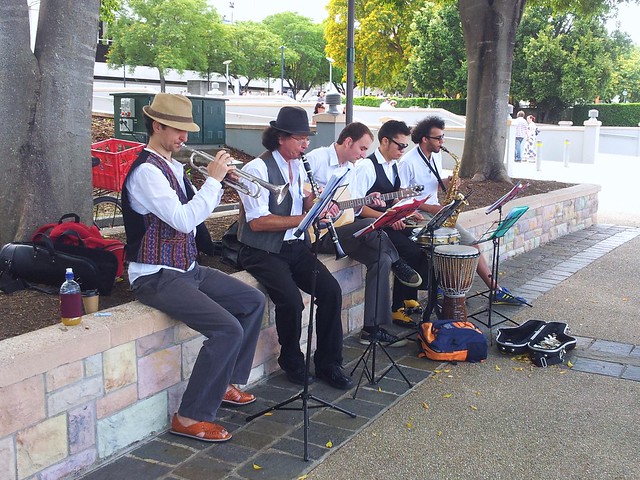
As usual, South Bank was abuzz with lots of activity. This Klezmer band got my toes tapping.

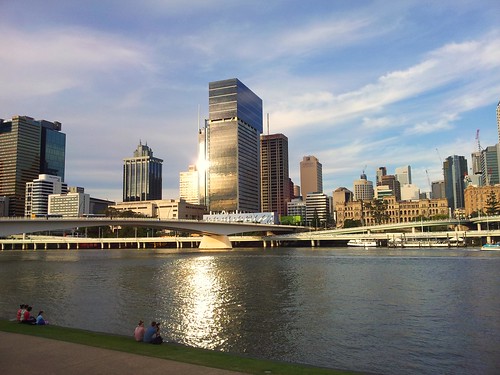
We enjoyed the walk along the riverside, watching the sun bouncing off the buildings. I was really surprised to see a vegetable garden down this end of South Bank. Rather than flowers, someone has planted Cauliflower, Fennel, Coriander and a myriad of other edible plants. It’s great to see.
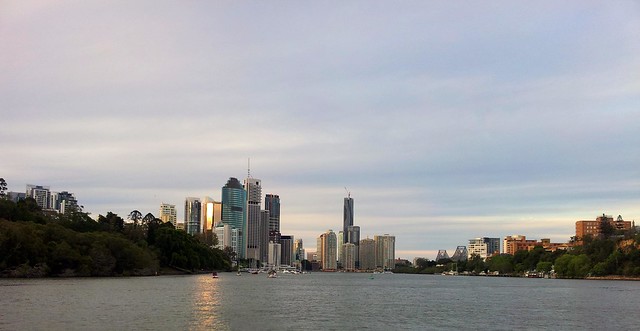
At the end of the day, we hopped back on the City Cat and rode back to Bretts Wharf at Hamilton.
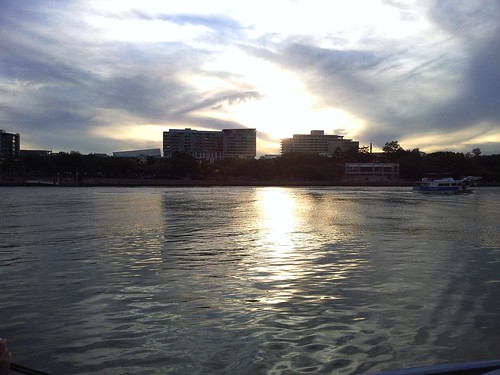

Harrison decided he preferred to stand up the front and let the wind blow him around.
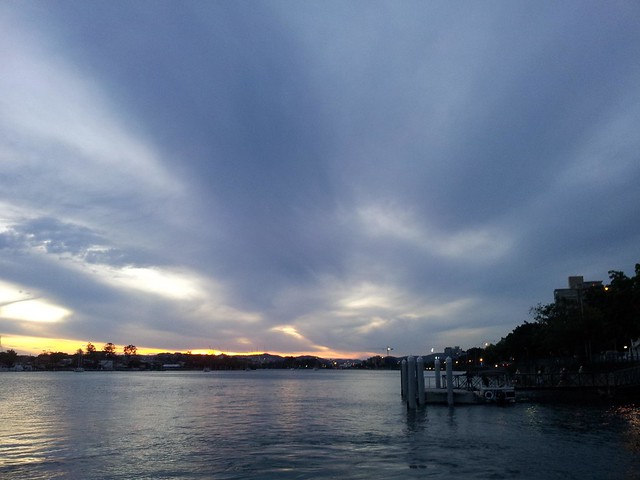
A great day. We made it up as we went along, and as luck would have it, everything turned out really well!







